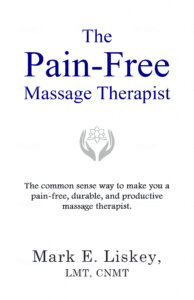Years ago I needed a photographer for my parents’ 5oth anniversary party. I chose a wizen-faced photographer who had been in the business for decades. After all, if you’ve been in business for that long, you had to be good…well, let me just say that we didn’t buy one of the pictures he took at the 5oth anniversary party. The flip side is also true—just because you’re relatively new at something doesn’t mean you’re going to be bad at it. It’s been my experience that the MTs who are good from the get-go do one thing extremely well: they find tight spots and provide pain relief in those areas.
It’s Important
How important is finding and effectively working tight spots? Very.The act of searching for tight spots shows the client that you’re engaged in the massage, that you care about what’s under your fingertips. And if you can provide pain relief to those tight areas, you’re going to have one happy client. Surprisingly not all therapists do this, including seasoned MTs. In addition, searching for tight spots and providing pain relief to those areas requires an MT to be able to operate in the full range of pressures (light, medium and deep). Honing your pressure skills through finding tight spots and providing pain relief makes hitting the “parasympathetic” pressure mark easy during a relaxation massage.
How to Search For Tight Spots
Here is my key for searching for a tight spot: create contrast. To create contrast, go to the area where you think the tight spot is, then go back and forth in a broad motion over the area. If you’re still having trouble finding it, press a little deeper. If that doesn’t work, do your back-and-forth stroke faster.
Make it Hurt So Good
Once you’ve found the tight spot, you want to apply the pressure that elicits the “hurts so good” response from the client. This is not always straightforward. Sometimes it requires more pressure than you’re using for the rest of the massage. Sometimes it requires less. You can handle establishing the pain-relief pressure a couple of ways.
Once you’re on the tight spot, you can flat out ask the client: Is this the “hurts so good” pressure? If not, adjust accordingly. Another way is to set up a 0 to 10 pain rating system with the client. Zero means there’s no pain and ten means there’s a lot of pain. Tell the client that when you press and hold a tight spot, you want the pain to be no greater than a 5. (You don’t want to promote a sympathetic response). If the client is experiencing anything greater than a 5, lessen your pressure.
Lastly, you can simply look for reaction signs to determine if your pressure is on target. Reactions signs are cues that the client is given you in response to the massage. The cues can positive, like deep breaths and sighs or they can be warning cues that you are applying too much pressure, like involuntary jumps, squirming and tightening of muscles. Warning cues mean you will need to lighten your pressure.
Get it From a Different Angle
Varying the angle of approach is another strategy for relieving tight spot pain. If you’ve pressed on the tight spot straight on with limited success, try pressing the tight spot on an angle or from the side. Also, if you vary your angle of approach you’re less likely to overwork an area and create a situation of diminishing returns.
You Don’t Need to Know Everything
Lack of experience does NOT mean you have to wait 5 years to be a good therapist. Nor do you have to know the name of every muscle you’re working on or be able to execute the latest massage technique to make a client happy. Practice finding tight spots and providing pain relief. As a result, you’ll feel comfortable with all ranges of pressure, and you can always layer on more anatomy and new techniques in the years to come.
Free Course to Jumpstart Your Massage Business
If you’re just starting a massage business and aren’t making 30K a year working for yourself take this free course: Jumpstart.







Comments on this entry are closed.